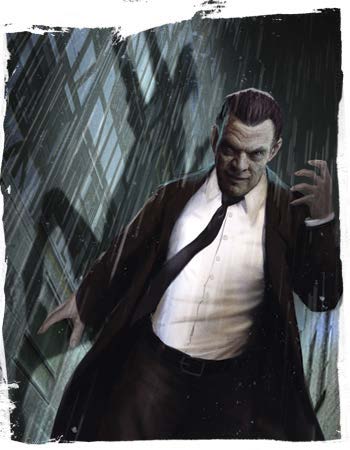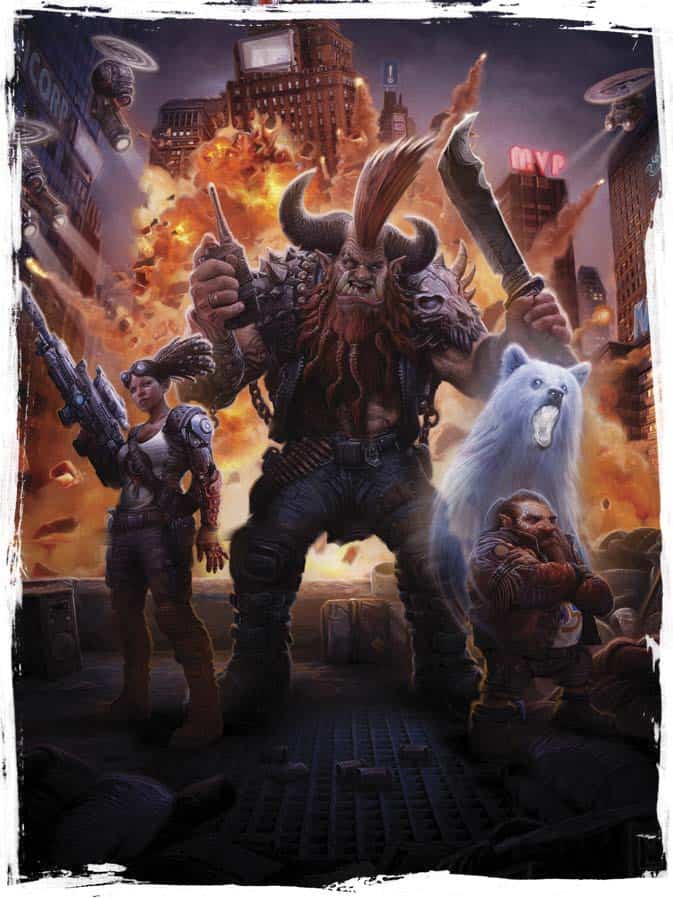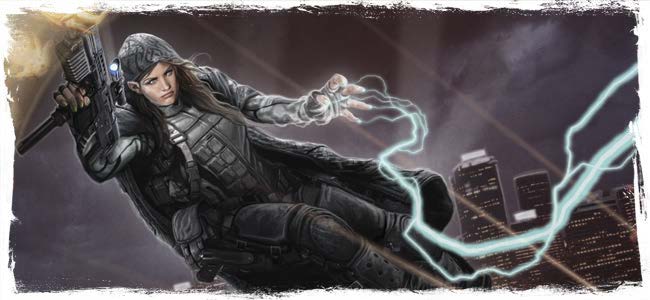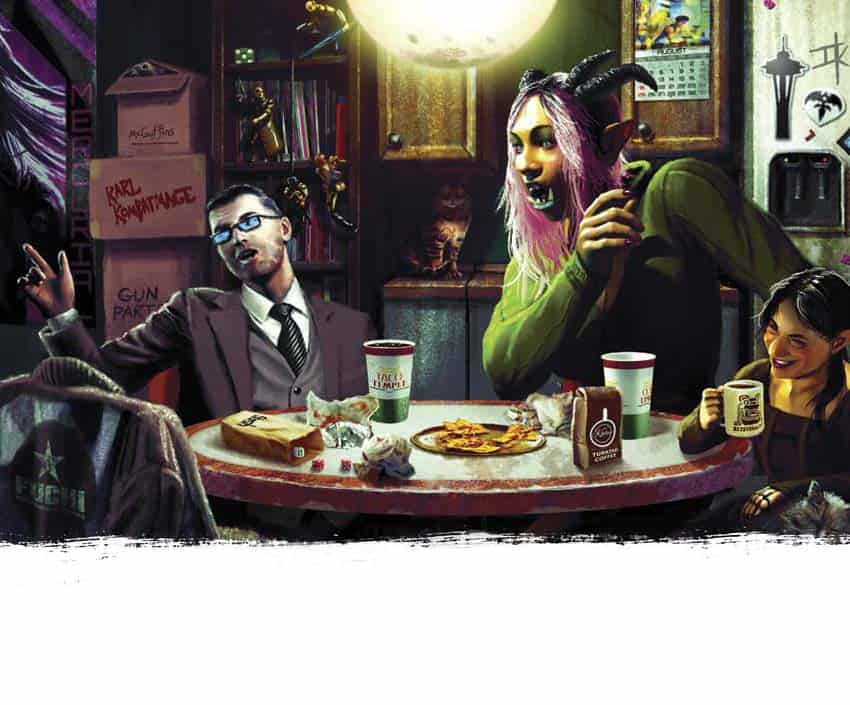As I was researching my article on the roleplaying game Shadowrun, I came across another game, Shadowrun Anarchy. Thinking it was the current edition, I started reading about it and decided I should explain what it is and how its different from Shadowrun Sixth World.
Shadowrun Anarchy takes the rich lore and setting of the Sixth World, but places it in the rules framework of more narrative games like Fate and Powered by the Apocalypse. This game is for those who love the stories they can tell in Shadowrun, but do not want its complexities.
Shadowrun takes place about fifty years in the future, but the world started changing in the early 2010s. Like many fictional settings, Shadow run takes our near past (or when it was originally written in the late 1980s their near future 20-years hence) and changes one or two things. It then asks, if our world changed in those ways, how would society respond and evolve?
Those two foundational twists, as the Anarchy book explains, were international corporate extra-territoriality and the return of magic into the world. The first twist is that large, international corporations (mega-corps) are granted the same legal status as sovereign nations. Whatever property they own is 100% under their control and not even a national government can regulate or interfere.
The second is the return of magic into the world. This causes many dormant or hidden magical creatures to return to our modern world. This includes the return of dragons: intelligent, strong, and magically powerful beings. Of course, other “para-normal” animals like basilisks emerge and sasquatches come out of hiding.
But something else happens, many humans suddenly and painfully transform in their teen years. These transformations turn them into meta-humans: dwarves, elves, orcs, and trolls are the most common. Sometimes they transform into other more exotic types. But when two meta-human dwarves love each other very much, their children are also dwarves.
The SINners and the SINless
In the societal chaos that followed, the world was quickly divided up into the new haves and have-nots. Aside from the normal distinctions, money (or nuyen as its called in the Sixth World), the other distinction is your SIN or System Identification Number.

To have a SIN means you’re part of polite society. A SIN is issued by any lawful, sovereign entity: the shell of national governments and the mega-corps. But if you’re convicted of a crime or fired from your Corp job, then you can have your SIN revoked. Or maybe you were born to the SIN-less, which means they cannot prove their national citizenship. Which means you are not entitled to a SIN.
You play Shadowrunners, mercenaries for hire who live in the shadow of the mega-corps. Idealists who try to bring hope by walking the line between the Neon-bright mega-corps and the dark despair of those living in the SINless slums. Whether a mercenary or revolutionary, you have bills to pay and the corps have the nuyen to hire disposable and deniable assets.
Running the Shadows
While Anarchy uses some of the same terminology as the regular Shadowrun system, it is doing so in a very rules-light, narrative way. This approach starts with character creation.
Anarchy has a slightly slimmed down set of Attributes compared to standard Shadowrun
- Strength — Muscle power, health, and physical resilience
- Agility — Hand-eye coordination, balance, and reaction time.
- Willpower — Mental grit, determination, and situational awareness
- Logic — Street smarts or book learning or both.
- Charisma — your presence in social situations and golden tongue
Compared with standard Shadowrun attributes, Body has been folded into Strength, Reaction into Agility, and Intuition into Willpower. This typifies how Anarchy tries to streamline Shadowrun’s system complexities.
While not quite Attributes, there are two other statistics you have to track in Anarchy:
- Essence — A measure of your humanity and spirit, assuming you didn’t carve it up for an artificial arm, subdural armor plating or some other physical alteration.
- Edge — your luck or fate. A resource you can spend to make things turn out your way.
But before we get further into Character details, the system actually wants you to start out with a Character Theme. If this is an ensemble drama series, what are your character’s descriptors in the script? The book gives several examples:
- male, late twenties, stoic and very tough, doesn’t talk much
- woman, early thirties, always smiling, with a devil-may-care attitude
- male, teen, with a brooding anger that he fails to leash more often than not
From there, you figure out your character’s name. While the book doesn’t suggest this, you should also determine your street name. Real names are dangerous because they create connections with real people, typically family. More important, if you’re one of the few Shadowrunners with a valid SIN, using your real name at the wrong time may cause problems.

TAGS: In the theme of simple, story-focused play, Anarchy uses a Tag system. Single words that describe who your character is, but not what they do or how they react. These Tags are used for Non-Player Characters, Monsters, Corporations, etc. They enable evocative play, even if the Tags are the only piece you know.
Cues: Anarchy also asks that you write down three “cues” about your character. At their most simplistic, they are trademark catch-phrases that tell you a lot about your character’s approach and outlook. Think of Hana Solo’s, “Never tell me the odds.”
Examples given in the book include:
- If I can’t hack, I shoot it. If I can’t shoot it, I run.
- Sorry, bro, I’m not that kind of elf.
- We should put more guns on that!
They book often gives the advice, if you’re not sure what to do, read over your Cues for inspiration.
What is the story you want to tell?
The next step requires your group to figure out what stories you are going to start with. Are you new to the shadows, dealing with the turf wars of the local Street Gangs? Or is your team established Shadowrunners, but still looking to make it into the big leagues? Finally, you play runners who are the prime players in the shadows, getting the first pick of the choicest jobs.
This choice determines how many points your characters have to spend on attributes, gear, and other starting items. But instead of the complex Priority List of standard Shadowrun, you just get a set package points. For example, as established Shadowrunners you get:
- Attributes; 16 points
- Skills: 12 points
- Shadow Amps: 10 points
- Weapons: 1 ranged, 1 melee
- Gear: Armor, 4 items, 2 contacts
These points can only spent in their own categories.
Shadow Amps are Shadow Amplifications. These represent several things. One is bioware or cyberware: the ways Runners can alter their body through the wonders of modern science and technology: new limbs, rewired neural networks, robotic eyes, special glands emitting mood-altering pheromes.
Another is your magical ability, spells, and rituals. Yet another is your cyberdeck and hacking programs for the Matrix (the AR and VR internet of the future). You can then spend additional points to enhance your amp to add armor piercing effects, increased armor, rerolling dice, etc. Any unspent Shadow Amp points become your Edge score.

Awakened or Emerged. The Awakened are those who can manipulate mana or magic. Emerged or those who can someone access the Matrix directly without the use of technology. You’ll need to decide if you are either as that will influence the type of Shadow Amps you purchase.
Weapons and Armor are what they seem. Gear should probably be called non-combat gear or everything else that is not a weapon or armor. Contacts are the professionals you know in the Shadows that you can call on when you need help. They could be fences, smugglers, street docs, etc.
Finally, before you start assigning points, you’ll have to determine which type of meta-human your are: Human, Elf, Dwarf, Ork, or Troll. Your choice will change a couple of attributes or skills. Each meta-human type also has maximum attributes of varying levels.
Rolling the Bones
Anarchy still uses the d6 dice pool mechanic of regular Shadowrun. Each level you have in an attribute and skill allows you to add a d6 into the pool of dice you roll. Furthermore, each skill is linked to a specific attribute. Your Shadow Amps also add to that dice pool.
When you roll your handful of d6s, you’re still looking for the fives and sixes, which are the successes or hits. If you spent Edge before the roll, then you are looking for four, fives, and sixes. The Game Master will tell you how many you need on a simple check. With opposed rolls, it is whether the attacker or aggressor had more hits than the defender.
What’s So Different About Anarchy?
As I was reading the Anarchy rulebook, especially after having read through the key parts of the Shadowrun Sixth World book, I was getting a sense of deja vu. This feels a lot like regular Shadowrun. That is both good and bad.
That’s good, because it’s maintaining the feel and core mechanics of the game. That’s bad, because for being a “rules-lite” version of the game, the Anarchy book still clocks in at 218 pages. The 5th Edition book is 489 pages and the Sixth Edition is a mere 322 pages. In Anarchy’s case, its lightness is relative to the core game.
But that is unfair to Anarchy, because it does have a very different, narrative play-style that sets it apart from core Shadowrun play. Whenever you start a scene, the Game Master sets the stage for the scene. It could be a non-combat, a combat, or a let’s see where it goes type of scene.
Once the stage is set, the player to the Game Master’s left takes narrative control. Typically that control lasts until one or two non-combat tests occur or a combat action is taken. Sometimes, the Game Master must step in simply because the player is taking too long. Then the narrative control moves to the next player.
This gives up a lot of narrative control to the players. While the Game Master is expected to roleplay the Non-player characters, set difficulty levels and roll on opposed checks, the player is suppose to tell the good and bad of the scene. Also, the other players are not suppose to interject (too much) during another player’s Narrative.
Plot Twists: But they don’t have quite unfettered control. Each player starts a session with three Plot Points (think of Bennies from Savage Worlds. Depending on the type of scene, their Shadow Amps may grant them additional Plot Points. It is recommended that you use actual tokens of some sort, like poker chips.
Players can spend these Plot Twists during their own Narration (turn) or during another player’s Narration. Game Masters have their own Plot Points (one at the start of a session and they keep each one spent by a player). The types of actions the book suggests include:
- Adding a glitch die to your or another player’s roll, which enables critical failures or successes.
- Take the next Narrative turn, even if it is out of order.
- Various combat actions (extra move, heal, take someone else’s hit, extra attack).

The inspiration here is to throw monkey wrenches into a player’s narration. This emphasizes a very improvisational (Yes! And …) style of play. Play continues until all of the players have a turn, then the Game Master gets to seize the Narration.
You have to Spend Plot Points to Earn Plot Points
Players earn more Plot Points through inspired Narration, emphasizing their Cues, and taking risks. They are limited to five at a time. The Game Master earns them when the Players spend their own. This encourages the Game Master to hand them out freely.
Also as in Savage Worlds or Fate, Players have to know they are going to get more Plot Points and easily or else they will horde them. That will make play less interesting. Never let a player end their turn with only one Plot Point or else they’ll horde it for “the right time” also known as never.
This is not suggested in Anarchy, but you could take a page from the Fantasy Flight Games Star Wars RPG books. In that game they have seven or nine double-sided tokens. One side is black, the other white (like in the game Othello). If a Player wants a bonus (use a Plot Point), then they flip over a white token to black. When the Game Master wants to access the dark side . . . I mean plot point, he flips a black token over to white.
Rather than the Plot points being an individual resource, they are a party resource. But that would undercut specific Shadow Amps that grant a player extra Plot Points. As with all House Rules, the hack is rarely elegant.
Hey Pal, your Karma is Showing!
While nuyen makes the world go round, keep track of each one is not a thing in Anarchy. Instead, all jobs simply pay in Karma. If you’ll recall, Karma is what Shadowrun uses for Experience Points. As you gain Karma, you can spend it to improve Attributes, Skills, Weapons/Armor, and Shadow Amps.
Like in Shadowrun proper, spending Karma on Attributes and Skills increases sharply for each additional point. You can only have four weapons and one set of armor (max rating of 12). Replacing or upgrading them soon becomes more a matter of style than function.
It is the Shadow Amps that will be in your top three of Karma Spends (along with Attributes and Skills). These represent getting the latest bioware and cyberware upgrades, learning a new spell (or empowering a spell you already know), or buying a new cyberdeck. But you can only have six different Shadow Amps.
This greatly simplifies Shadowrun’s interminable shopping episodes. Instead of checking your underworld contacts, consulting the item’s rarity or level of illegality, and running opposed negotiation rolls, players just spend Karma and get what they want.
Final Thoughts
Having read through Anarchy, the Shadowrun Sixth World rulebook, and having played earlier editions of Shadowrun, I much prefer the Anarchy approach to game play. This is not a Rules Lite game, but just a normal amount of rules compared to Shadowrun’s rule-caloric density.
The Narrative control part is a fun addition, but character creation is still somewhat fiddly. Fortunately, the Anarchy book comes with a healthy set of pre-generated, evocative characters.
Combat is still a “do I hit?” set of opposed checks followed by a “did I damage anything” set of opposed checks. Out-of-combat magic is simplified, but combat magic is that same set of opposed checks. Matrix hacking starts with simple skill tests with Matrix Combat being its own set of opposed checks.
If you want to explore the wilder (and wider) world of tabletop roleplaying games go there! If you want to start to learn on how to paint miniatures, click already! Or maybe you want to read more of my posts about Dungeons and Dragons, then click away here!

